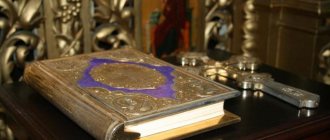The attitude of the church towards Rasputin has a negative connotation. Many clergy call him a servant of Satan, who through his activities caused the collapse of the Russian Empire and provoked the death of people who trusted him. The Siberian wanderer Gregory appears as an allegorical personification of human suffering: through this man, sinister demons entered the world and destroyed many souls.
The Church assumes that revolutionary madness, the destruction of churches, the desecration of shrines and the destruction of those who disagree with the authorities began with G. Rasputin.
Church opinion
The Russian Orthodox Church does not have an official and categorical point of view regarding the Siberian wanderer. The question of the role of G. Rasputin is considered more often from the perspective of history, and not through the prism of theology.
How does the church feel about Rasputin?
- This man stopped doubting his divine destiny after meeting John of Kronstadt, the spiritual leader of the Orthodox Church at the beginning of the 20th century. The saint saw in G. Rasputin a spark of true faith, but warned him not to abuse his name and not provoke strong changes in the future.
- The Holy Fathers offered him study at a theological academy, where he could direct his potential in the right direction, but Gregory modestly refused any offers. People called Rasputin a “wanderer” or an “old man.” In the first months of his arrival in St. Petersburg, bishops, archimandrites and teachers of theological gymnasiums treated him favorably.
- During his lifetime, this “man of God” became a legend in Russia; rumors obscured the image of the real person. Many researchers tried to understand the reasons for the mystical influence that Rasputin had on the royal family.
- Interest in “wanderers” in those days was fueled by the search for spiritual needs in the Orthodox faith and the unconditional resolution of doubts of religiosity. People stopped trusting the dogmas of the Church, it was popular to look for answers from the newly arrived prophets, and not from those holy fathers who demonstrated the righteousness of their actions and fabrications. In such an unhealthy environment that arose at the beginning of the 20th century, Rasputin felt excellent.
- According to Metropolitan Veniamin, he assumed the authority of a manager early because he himself did not have proper religious leadership. Gregory went to a society where Orthodoxy had no support, and sinfulness reigned irrepressibly. It was the soil into which this man came that provoked the growth of harmful inclinations in him.
- There is an assumption that Nicholas II wanted to keep the Siberian wanderer Gregory near the throne, who could convey to the tsar all the problems of the common people. A big plus for the ruler was that the “elder” was extremely different from the traditional priests. Even despite the facts provided about the wild life of the “elder,” Nicholas II had more confidence in him than in his own officials.
About the royal family:
- Akathist to the Holy Royal Passion-Bearers
- Icon of the Holy Martyr Queen Alexandra
- The problem with Rasputin is the perception of him as a “living symbol.” Opinions about the “wanderer” varied radically: some spoke about him in negative terms, others saw holiness in this man. The Orthodox Church called Rasputin a libertine and an impudent man. Many knew about his disgraces and drunkenness, which the “elder” soon smoothed over with meek and pious behavior at church services.
On a note! In Gregory, two opposing principles fought: what is called “lowly” won. He considered his sinful life and subsequent victory over it the basis for the transformation of his soul. Rasputin supported the opinion that repentance comes only after falling into the abyss of darkness. The agitation of such “morality” was used for self-interest.
Rasputin and the Church. Firsov S. L.
Protopopov) and others, who used him as an intermediary in their relations with Nicholas II and the Empress, seeking their subordination to their influence. These goals were served by the appointments of prime ministers N.A. Maklakov, B.V. Sturmer, ministers P.L. Bark, D.I. Shakhovsky, Protopopov, carried out through Rasputin, as well as the “ministerial leapfrog” - from September 1916 to February 1917 3 chairmen of the Council of Ministers were replaced, 2 ministers of agriculture were replaced, and 88 out of 167 governors were removed. Rasputin and his entourage were directly involved in creating disorder in the spheres of influence of departments, which deepened the economic crisis in the country, and persuaded Nicholas II to accept the post of commander in chief (August 1915). In 1916, the monarchists (Grand Duke Dmitry Pavlovich, the emperor’s relative Prince F. F. Yusupov, the leader of the monarchists V. M. Purishkevich) plotted to assassinate Rasputin. On the night of December 17, 1916, Rasputin was killed in the Yusupov Palace (Moika River embankment, 94), the corpse was lowered under the ice of the Malaya Nevka near the Elagin Bridge. On December 21, 1916, Rasputin was buried in the presence of the imperial family in Tsarskoye Selo Park. In the February days of 1917, his ashes were removed from the grave and burned in the furnace of a steam boiler at the Polytechnic Institute. Having weakened the forces of the monarchy, "R." accelerated the development of revolutionary events.
Sectarian or freethinker
Scandalous fame did not come to the Siberian wanderer immediately upon his arrival in St. Petersburg. In 1908, relations between Rasputin and the Church began to deteriorate: Archimandrite Veniamin tried to put him in his place through Prince Orlov, but this did not bring results. Soon the name of the “wanderer” becomes famous, but has a connotation of wild life.
The attitude of the church towards Rasputin
Gregory had long been closely watched and suspected of sectarianism, which was proven by his unreasonable zeal for the salvation of his own soul, personal pride and intolerable arrogance. The “elder” was fond of false sciences and philosophies, allowed himself carnal pleasures and convinced his charges to self-deify. This is where new dogmas arise, born of the sect leader (false Christ).
However, Rasputin is more like a religious freethinker who loves controversy and does not respect the authorities of the church hierarchy. The “elder” helped Tsarevich Alexei and received other sick people, but he repaid with a sense of self-interest. The nature of this man strived for popularity, he was pleased with the opportunity to become the center of attention. Over time, sinful vanity completely consumed Rasputin; the words of the Siberian wanderer were replete with a sense of self-importance.
Since 1915, Gregory's insidious interference in government affairs has been observed. The authorities compromised themselves, which led to disruptions in work and a sharp narrowing of the social base. A “ministerial leapfrog” was observed at the throne, where officials of opposing beliefs sought to overthrow each other from their posts.
On a note! Actually, the Church was for Rasputin only a source of blessed energy during services.
The Siberian wanderer felt self-sufficient dark energy and a terrible desire to destroy certain goals. His personal religion became sexual lust and crude materialism, disguised by hypocrisy and impenetrable pride.
About other sins:
- Covetousness
- Extortion
- Love of money
The Russian Orthodox Church refused to canonize Rasputin and Ivan the Terrible
Rasputin managed to convince Nicholas II and the Empress that only he, with his prayers, could save the terminally ill hemophiliac heir Alexei and provide “divine” support for the reign of Nicholas II. Gorokhovaya street, house 64, apartment 20 - Rasputin’s last place of residence in St. Petersburg (since May 1914) - became a center of attraction for swindlers of various ranks. Rasputin's influence on the emperor was used by representatives of the stock exchange and banks (I. P. Manus, A. I. Putilov, D. L. Rubinstein), high-ranking adventurers (I. F. Manusevich-Manuylov, Prince M. M. Andronikov), Black Hundreds and reactionary circles (Prince V.P. Meshchersky, A.N. Khvostov, P.G. Kurlov, A.D. Protopopov) and others, who used him as an intermediary in their relations with Nicholas II and the Empress, seeking their subordination to their influence. These goals were served by the appointments of prime ministers N.A. Maklakov, B.V. Sturmer, ministers P.L. Bark, D.I. Shakhovsky, Protopopov, carried out through Rasputin, as well as the “ministerial leapfrog” - from September 1916 to February 1917 3 chairmen of the Council of Ministers were replaced, 2 ministers of agriculture were replaced, and 88 out of 167 governors were removed. Rasputin and his entourage were directly involved in creating disorder in the spheres of influence of departments, which deepened the economic crisis in the country, and persuaded Nicholas II to accept the post of commander in chief (August 1915). In 1916, the monarchists (Grand Duke Dmitry Pavlovich, the emperor’s relative Prince F. F. Yusupov, the leader of the monarchists V. M. Purishkevich) plotted to assassinate Rasputin. On the night of December 17, 1916, Rasputin was killed in the Yusupov Palace (Moika River embankment, 94), the corpse was lowered under the ice of the Malaya Nevka near the Elagin Bridge. On December 21, 1916, Rasputin was buried in the presence of the imperial family in Tsarskoye Selo Park. In the February days of 1917, his ashes were removed from the grave and burned in the furnace of a steam boiler at the Polytechnic Institute. Having weakened the forces of the monarchy, "R." accelerated the development of revolutionary events.
the name adopted in literature for the court camarilla in the state apparatus, one of the clearest manifestations of the crisis of the ruling elite of the Russian Empire on the eve of the February Revolution. In the last years of the tsarist regime, the adventurer G. E. Rasputin (1864 or 1865, according to other sources, 1872-1916) enjoyed unlimited influence on Nicholas II and the imperial family, who, wandering through monasteries, gained the reputation of a “holy elder” and “soothsayer” . In 1907 he was introduced into the imperial palace, where by this time a number of “saints”, charlatans and holy fools had already visited (N. Philip, Papus, Mitya Kozelsky, etc.). Rasputin managed to convince Nicholas II and the Empress that only he, with his prayers, could save the terminally ill hemophiliac heir Alexei and provide “divine” support for the reign of Nicholas II. Gorokhovaya street, house 64, apartment 20 - Rasputin’s last place of residence in St. Petersburg (since May 1914) - became a center of attraction for swindlers of various ranks. Rasputin's influence on the emperor was used by representatives of the stock exchange and banks (I. P. Manus, A. I. Putilov, D. L. Rubinstein), high-ranking adventurers (I. F. Manusevich-Manuylov, Prince M. M. Andronikov), Black Hundreds and reactionary circles (Prince V.P. Meshchersky, A.N. Khvostov, P.G. Kurlov, A.D.
The influence of the personality of Grigory Rasputin on popular culture
After his death, Grigory Rasputin turned into a hero of fiction. People in the West like to refer to his image. Today, Rasputin is perceived there as a symbol of the mysterious Russian soul, a mystic and a villain. And it all started six months after his death.
Films were released in the United States that tried to depict in a documentary manner the revolutionary events that were then taking place in Russia. In the 20s and 30s, interest in the figure of the old man did not decline either. Rasputin's intrigues were the easiest way to explain to the masses why the Romanov dynasty fell and gave way to the Bolsheviks.
Russian emigrants who worked in Western cinema had the opportunity to earn money as experts on the “Russian soul” and history.
Artists continue to use the figure of Rasputin today. The mega-villain even appears in the cartoon. For example, in the 1997 cartoon “Anastasia”. The dubious plot shows how the Tsar expelled a charlatan who sold his soul to the devil in exchange for mystical power and now takes revenge on the Romanovs - causing a revolution. And in 1913.
But Rasputin looks even more absurd in the Hellboy comics. Here the gods of chaos revived the old man in order to return to the human world with his help. According to the plot of Western fiction, during the Second World War, Gregory offered services to the Nazis and opened a portal to the underworld, giving Hellboy a way out.
The image of Rasputin was also filmed in Russia. And also in a distorted form. For example, in Elem Klimov’s film “Agony” he was presented as a superman, a hero.
Over the years, the image of Rasputin was embodied by Gerard Depardieu, Ivan Okhlobystin, Vladimir Mashkov. But each time it was not a truthful description, but the exploitation of a well-promoted brand.











